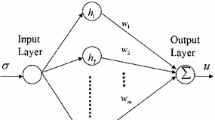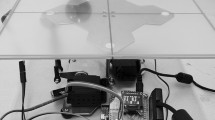Abstract
In this paper, an adaptive sliding mode neural network(NN) control method is investigated for input delay tractor-trailer system with two degrees of freedom. An uncertain camera-object kinematic tracking error model of a tractor car with n trailers with input delay is proposed. Radial basis function neural networks(RBFNNs) are applied to approximate the unknown functions in the error model. A sliding mode surface with variable structure control is designed by using backstepping method. Then, an adaptive NN sliding mode control method is thus obtained by combining Lyapunov-Krasovskii functionals. The controller realizes the global asymptotic trajectories tracking of the kinematics system. The stability of the closed-loop system is strictly proved by the Lyapunov theory. Matlab simulation results demonstrate the feasibility of the proposed method.
Similar content being viewed by others
References
J. Wang, S. He, and D. Lin, “Robust backstepping control for a class of nonlinear systems using generalized disturbance observer,” International Journal of Control, Automation and Systems, vol. 14, no. 6, pp. 1475–1483, 2016.
K. Xie, C. Chen, F. L. Lewis, and S. Xie, “Adaptive asymptotic neural network control of nonlinear systems with unknown actuator quantization,” IEEE Transactions on Neural Networks & Learning Systems, vol. 29, no. 12, pp. 6303–6312, 2018.
J. de J. Rubio, “Robust feedback linearization for nonlinear processes control,” ISA Transactions, vol. 74, pp 155–164, 2018.
J. de J. Rubio, G. Ochoa, D. Mujica-Vargas, E. Garcia, R. Balcazar, I. Elias, D. R. Cruz, C. F. Juarez, A. Aguilar, and J. F. Novoa, “Structure regulator for the perturbations attenuation in a quadrotor,” IEEE Access, vol. 7, no. 1, pp. 138244–138252, 2019.
J. Kumar, V. Kumar, and K. P. S. Rana, “Design of robust fractional order fuzzy sliding mode PID controller for two link robotic manipulator system,” Journal of Intelligent & Fuzzy Systems, vol. 35, no. 5, pp. 5301–5315, 2018.
J. de J. Rubio, A. Aguilar, J. A. Meda-Campaña, G. Ochoa, R. Balcazar, and J. Lopez, “An electricity generator based on the interaction of static and dynamic magnets,” IEEE Transactions on Magnetics, vol. 55, no. 8, 8204511, 2019.
Q. Zhang, J. Zhang, and Y. Wang, “Sliding-mode control for singular markovian jump systems with brownian motion based on stochastic sliding mode surface,” IEEE Transactions on Systems, Man, and Cybernetics: Systems, vol. 49, no. 3, pp. 494–505, 2017.
J. Qiao, Z. Li, and H. Wang, “Adaptive sliding mode control with nonlinear disturbance observer for uncertain nonlinear system based on backstepping method,” Proceedings of the 10th World Congress on Intelligent Control and Automation, pp. 1609–1614, 2012.
M. Van, M. Mavrovouniotis, and S. S. Ge, “An adaptive backstepping nonsingular fast terminal sliding mode control for robust fault tolerant control of robot manipulators,” IEEE Transactions on Systems, Man, and Cybernetics: Systems, vol. 49, no. 7, pp. 1448–1458, 2018.
Y. Li, S. Qiang, X. Zhuang, and O. Kaynak, “Robust and adaptive backstepping control for nonlinear systems using rbf neural networks,” IEEE Transactions on Neural Networks, vol. 15, no. 3, pp. 693–701, 2004.
H. Yang and J. Liu, “An adaptive RBF neural network control method for a class of nonlinear systems,” IEEE/CAA Journal of Automatica Sinica, vol. 5, no. 2, pp. 457–462, 2018.
Y. Si, J. Pu, B. Lu, and L. Sun, “An improved adaptive neural network sliding mode method for tracking control,” Proc. of Chinese Automation Congress (CAC), pp. 3967–3972, 2018.
M. Wang, B. Chen, K. Liu, X. Liu, and S. Zhang, “Adaptive fuzzy tracking control of nonlinear time-delay systems with unknown virtual control coefficients,” Information Sciences, vol. 178, no. 22, pp. 4326–4340, 2008.
M. Jankovic, “Control Lyapunov-Razumikhin functions and robust stabilization of time delay systems,” IEEE Transactions on Automatic Control, vol. 46, no. 7, pp. 1048–1060, 2001.
Z. Gao, T. Zhang, J. Mao, and J. Chen, “Adaptive control of nonlinear systems with unmodeled dynamics and time-varying state delays,” Proc. of the 32nd Chinese Control Conference, pp. 2844–2849, 2013.
S. Tong and Y. Li, “Observer-based fuzzy adaptive robust control of nonlinear systems with time delays and unmodeled dynamics,” Neurocomputing, vol. 74, no. 3, pp. 369–378, 2010.
B. Zhou, “Input delay compensation of linear systems with both state and input delays by nested prediction,” Automatica, vol. 50, pp 1434–1443, 2014.
B. Zhou, Q. S. Liu, and F. Mazenc, “Stabilization of linear systems with both input and state delays by observer-predictors,” Automatica, vol. 83, pp 368–377, 2017.
B. Zhou, “Pseudo-predictor feedback stabilization of linear systems with time-varying input delays,” Automatica, vol. 50, pp 2861–2871, 2014.
M. Yue, X. Wu, L. Guo, and J. Gao, “Quintic polynomial-based obstacle avoidance trajectory planning and tracking control framework for tractor-trailer system,” International Journal of Control, Automation and Systems, vol. 17, pp. 2634–2646, 2019.
N. T. Binh, N. A. Tung, D. P. Nam, and N. H. Quang, “An adaptive backstepping trajectory tracking control of a tractor trailer wheeled mobile robot,” International Journal of Control, Automation and Systems, vol. 17, no. 3, pp. 465–473, 2019.
O. J. Sordalen, “Conversion of the kinematics of a car with n trailers into chained form,” Proc. of IEEE International Conference on Robotics & Automation, pp. 382–387, 1993.
W. E. Dixon, D. M. Dawson, E. Zergeroglu, A. Behal, “Adaptive tracking control of a wheeled mobile robot via an uncalibrated camera system,” IEEE Transactions on Systems, Man, and Cybernetics, Part B (Cybernetics), vol. 31, no. 3, pp. 341–352, 2001.
J. P. Laumond, “Controllability of a multibody mobile robot,” IEEE Transactions on Robotics & Automation, vol. 9, no. 6, pp. 755–763, 1993.
P. Souères, Modèle Différentiel d’un Robot Mobile Tractant des Remorques, DEA Rep., P. Sabatier Univ., Toulouse, France, 1990.
Z. P. Jiang and H. Nijmeijer, “A recursive technique for tracking control of nonholonomic systems in chained form,” IEEE Transactions on Automatic Control, vol. 44, no. 2, pp. 265–279, 1997.
P. Zhang and J. P. Zhang, “Study on chattering of variable structure control,” Aero Weaponry, no. 2, pp. 9–13, 2013.
Author information
Authors and Affiliations
Corresponding author
Additional information
Recommended by Associate Editor Quoc Chi Nguyen under the direction of Editor Myo Taeg Lim.
This work was supported by the National Natural Science Foundation of China (61473179, 61903234), Shandong Procincial Natural Science Foundation (ZR2017LF011, ZR2019MF008)
Zengke Jin received his B.S. degree from the School of Mathematics, Inner Mongolia University for Nationalities in 2017. He is currently an M.S. student at the School of Mathematicsand Statistics, Shandong Universityof Technology. His research interests include nonlinear control, visual servoing feedback control, and neural network control.
Zhenying Liang received her Ph.D. degree from the Department of Control Science and Engineering, University of Shanghai for Science and Technology in 2011. She received her B.S. and M.S. degrees in mathematics from Shandong Normal University in 1986, and Liaoning Normal University in 1991, respectively. Her research interests cover nonlinear control, robust control, and visual servoing feedback control.
Xi Wang received her B.S. degree in School of Mathematics from Changzhi University, ChangZhi, China in 2018, and studying in the School of Mathematics and Statistics from Shan Dong University of Technology.
Mingwen Zheng received his Ph.D. degree from the Beijing University of Postsand Telecommunications in 2018. He received his B.S. degree from the School of Science, Shandong University of Technology in 2002, and an M.S. degree from School of Computer and Communication Engineering, China University of Petroleum in 2009. His current research interests include complex dynamical network, neural network, and memristors.
Publisher’s Note
Springer Nature remains neutral with regard to jurisdictional claims in published maps and institutional affiliations.
Rights and permissions
About this article
Cite this article
Jin, Z., Liang, Z., Wang, X. et al. Adaptive Backstepping Sliding Mode Control of Tractor-trailer System with Input Delay Based on RBF Neural Network. Int. J. Control Autom. Syst. 19, 76–87 (2021). https://doi.org/10.1007/s12555-019-0796-8
Received:
Revised:
Accepted:
Published:
Issue Date:
DOI: https://doi.org/10.1007/s12555-019-0796-8




